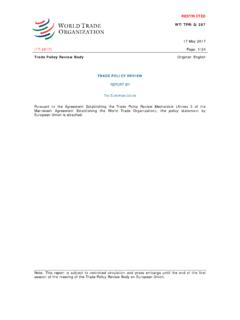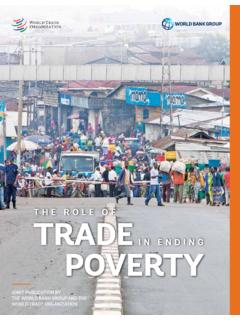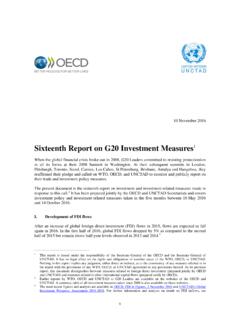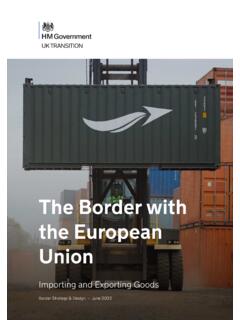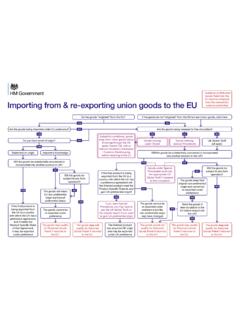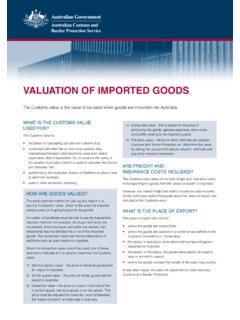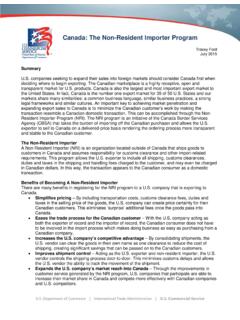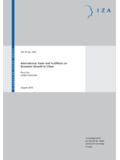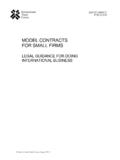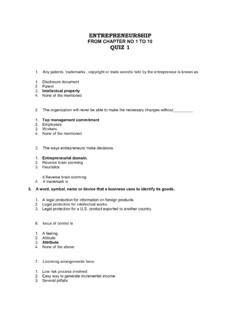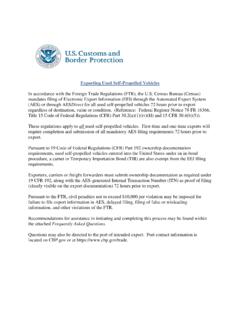Transcription of TRADE IN MEDICAL GOODS IN THE CONTEXT OF …
1 3 April 2020 Page: 1/16 Original: English TRADE IN MEDICAL GOODS IN THE CONTEXT OF TACKLING COVID-19 INFORMATION NOTE1 KEY POINTS: Germany, the United States (US), and Switzerland supply 35% of MEDICAL products2; China, Germany and the US export 40% of personal protective products; Imports and exports of MEDICAL products totalled about $2 trillion, including intra-EU TRADE , which represented approximately 5% of total world merchandise TRADE in 2019; TRADE of products described as critical and in severe shortage in COVID-19 crisis totalled about $597 billion, or of total world TRADE in 2019; Tariffs on some products remain very high.
2 For example, the average applied tariff for hand soap is 17% and some WTO Members apply tariffs as high as 65%; Protective supplies used in the fight against COVID-19 attract an average tariff of and goes as high as 27% in some countries; The WTO has contributed to the liberalization of TRADE MEDICAL products in three main ways: The results of tariff negotiations scheduled at the inception of the WTO in 1995; Conclusion of the plurilateral sectoral Agreement on Pharmaceutical Products ("Pharma Agreement") in the Uruguay Round and its four subsequent reviews; The Expansion of the Information Technology Agreement in 2015.
3 1 INTRODUCTION The COVID-19 pandemic has brought considerable attention to TRADE in MEDICAL products, and specifically TRADE in products for prevention, testing and treatment. The COVID-19 pandemic has spread to most countries and territories with hundreds of thousands of people infected, and a growing burden of fatalities. Understandably, governments are taking protective measures to stem the pandemic of the virus. Some of these measures may inadvertently impact the flow of critical MEDICAL GOODS across territories. This study provides a comprehensive overview of TRADE and tariffs imposed on MEDICAL GOODS in general, many of which appear to be in severe shortage as a result of the current crisis.
4 The purpose of this note is to provide factual information on how these GOODS are traded globally. 1 This document has been prepared under the Secretariat's own responsibility and is without prejudice to the positions of Members or to their rights and obligations under the WTO. 2 The values of imports and exports in this study are calculated at HS 6-digit subheading level. Those subheadings could cover products that are for non- MEDICAL use. 2 2 PRODUCT SCOPE MEDICAL products, in general, are widely spread in different Chapters of the Harmonized System (HS) classification.
5 This note seeks to analyse a set of products that are considered relevant to COVID-19 prevention and MEDICAL treatment in general. The specific HS 6-digit subheading codes are listed in Annex These COVID-19 relevant MEDICAL products are categorized into four main groups: 1. Medicines (Pharmaceuticals) including both dosified and bulk medicines; 2. MEDICAL supplies refers to consumables for hospital and laboratory use ( alcohol, syringes, gauze, reagents, etc); 3. MEDICAL equipment and technology; and 4. Personal protective products hand soap and sanitizer, face masks, protective It should be noted that this note focuses solely on the final form of these products and does not extend to the different intermediate products that are used by global value chains in their production.
6 The protective garments for surgical/ MEDICAL use are not included in the analysis, because it is impossible to distinguish them from general clothing product in the HS classification. A subset of MEDICAL products has been frequently mentioned by governments, international organizations and in news reports as in short supply for the fight against COVID-19. These include: disinfectants/ sterilization products; face masks; gloves; hand soap and sanitizer; patient monitors and pulse oximeters; protective spectacles and visors; sterilizers; syringes; thermometers; ultrasonic scanning apparatus; ventilators, oxygen masks; X-ray equipment; and other devices such as computer tomography apparatus.
7 TRADE in these products collectively amounts to of world merchandise TRADE . 3 TRADE PATTERNS Imports MEDICAL products account for approximately 5% of total world TRADE (imports and exports); more than half of imports are medicines World imports of MEDICAL products totalled $1011 billion in 2019 (Table 1), a 5% increase from 2018. Together with exports, TRADE in these MEDICAL products amounted about $2 trillion and accounted for 5% of the total of merchandise TRADE in 2019. As shown in Chart 1, the largest category by value were the "medicines", which represents 56% of the total value of MEDICAL product imports, followed in a distant second place by " MEDICAL supplies" with a share of 17%.
8 " MEDICAL equipment" and "personal protective equipment" have the lowest share with 14% and 13%, respectively. 3 This product list and categorization are compiled by the WTO Secretariat, partly based on the health products used in WTO Working Paper - More TRADE for Better Health? International TRADE and Tariffs on Health Products (Matthias Helble 2012). 4 Including the products identified by the WCO HS Classification reference for Covid-19 MEDICAL supplies ( ). 3 Chart 1: Imports of MEDICAL GOODS , by product category (2019) Source: WTO Secretariat. Top importers: the US, Germany, and China account for 34% of total world imports of MEDICAL GOODS During the last three years, the United States was the largest importer of MEDICAL products, accounting for 19% of total world imports in 2019.
9 The ranking and shares are consistent during the 2017-2019 period. As shown in Table 1, Germany had a share of 9%, followed by China and Belgium (6%). The other importers who make up the top 10 importers include the Netherlands, Japan, UK, France, Italy, and Switzerland. In terms of the relative importance of MEDICAL GOODS vis-a-vis each country's total imports, Belgium and Switzerland's imports of MEDICAL GOODS represent around 13% of their total imports. Among the top 10 importers, this share is smallest for China, for which MEDICAL imports represent 3% of its total imports. Except for China, the shares of the Member in the top 10 are all higher than the global average share, 6%.
10 Table 1: Top 10 importers of MEDICAL GOODS , 2019 Country Total imports Share of world MEDICAL imports (%) Share of total MEDICAL imports (%) Value ($ billion) Share of imports of all products (%) MEDICAL equipment MEDICAL supplies Medicines Personal protective products World 1, 6 100 14 17 56 13 1. United States 8 19 16 16 59 10 2. Germany 7 9 12 18 57 13 3. China 3 6 23 15 46 16 4. Belgium 13 6 8 12 75 5 5. Netherlands 8 5 16 20 55 8 6. Japan 6 4 16 16 56 13 7. United Kingdom 6 4 11 15 62 12 8. France 6 4 12 20 53 15 9.





